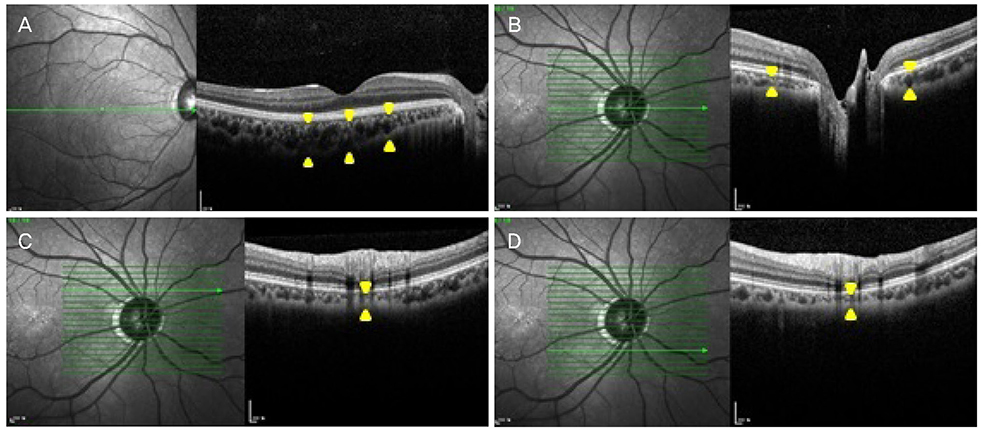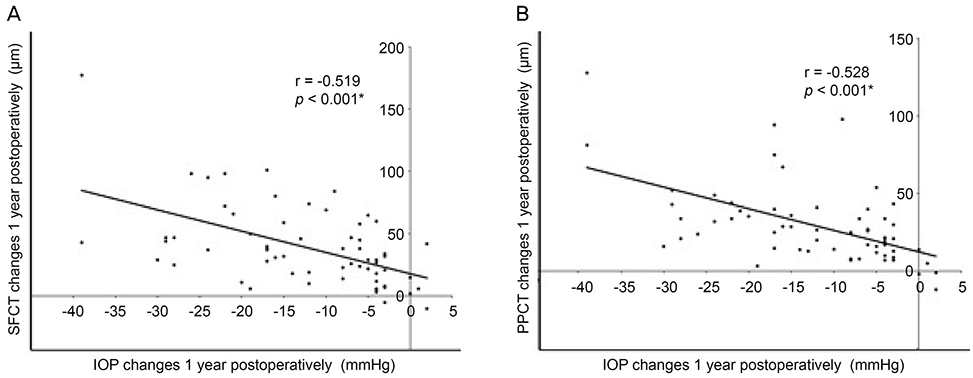J Korean Ophthalmol Soc.
2020 Jan;61(1):69-77. 10.3341/jkos.2020.61.1.69.
Long-term Longitudinal Changes in Choroidal Thickness with Intraocular Pressure Reduction after Glaucoma Surgery
- Affiliations
-
- 1Department of Ophthalmology, Yeungnam University College of Medicine, Daegu, Korea. sccha@ynu.ac.kr
- 2Daegu Premier Eye Center, Daegu, Korea.
- KMID: 2468478
- DOI: http://doi.org/10.3341/jkos.2020.61.1.69
Abstract
- PURPOSE
We investigated the long-term longitudinal changes in axial length (AL), mean ocular perfusion pressure (MOPP), and choroidal thickness (CT) according to the reduction of intraocular pressure (IOP) after glaucoma surgery. The potential variables associated with CT changes were also evaluated.
METHODS
This was a prospective study for 1 year after glaucoma surgery, which included 71 eyes of 71 patients with primary open-angle glaucoma. The subfoveal CT (SFCT) and peripapillary CT (PPCT) were measured using spectral-domain optical coherence tomography preoperatively and 1 week, 1 month, 2 months, 6 months, and 1 year postoperatively. MOPP was calculated from the IOP and blood pressure. The AL was measured using partial coherence interferometry. Regression analysis was conducted to assess the possible association of variables.
RESULTS
The AL decreased and the MOPP, SFCT, and PPCT increased significantly with IOP reduction at 1 year post-operatively (all, p < 0.001). The changes in SFCT and PPCT were significantly associated with IOP reduction at 1 year postoperatively (r = −0.519 and r = −0.528, respectively). Importantly, greater increases in SFCT and PPCT were found in patients with IOP reduction more than 30% from baseline, when compared with those with less than 30% reduction (p = 0.001 and p = 0.002, respectively). The SFCT increased more significantly in patients with AL ≤ 24 mm, compared with patients with AL > 24 mm (p = 0.044).
CONCLUSIONS
Reduction in the IOP, increase in the MOPP, decrease in the AL, and increase in the CT after glaucoma surgery persisted for 1 year during a long-term follow-up. These results suggested that glaucoma surgery reduced mechanical compression on the optic nerve fiber and increased intraocular blood flow.
Keyword
MeSH Terms
Figure
Reference
-
1. Hyman L, Wu SY, Connell AM, et al. Prevalence and causes of visual impairment in The Barbados Eye Study. Ophthalmology. 2001; 108:1751–1756.2. Quigley HA, Broman AT. The number of people with glaucoma worldwide in 2010 and 2020. Br J Ophthalmol. 2006; 90:262–267.
Article3. Hayreh SS. Blood supply of the optic nerve head and its role in optic atrophy, glaucoma, and oedema of the optic disc. Br J Ophthalmol. 1969; 53:721–748.
Article4. Duijm HF, van den Berg TJ, Greve EL. Choroidal haemodynamics in glaucoma. Br J Ophthalmol. 1997; 81:735–742.
Article5. Grunwald JE, Piltz J, Hariprasad SM, DuPont J. Optic nerve and choroidal circulation in glaucoma. Invest Ophthalmol Vis Sci. 1998; 39:2329–2336.6. Schulzer M. Intraocular pressure reduction in normal-tension glaucoma patients. The Normal Tension Glaucoma Study Group. Ophthalmology. 1992; 99:1468–1470.7. Heijl A, Leske MC, Bengtsson B, et al. Reduction of intraocular pressure and glaucoma progression: results from the Early Manifest Glaucoma Trial. Arch Ophthalmol. 2002; 120:1268–1279.8. Kass MA, Heuer DK, Higginbotham EJ, et al. The Ocular Hypertension Treatment Study: a randomized trial determines that topical ocular hypotensive medication delays or prevents the onset of primary open-angle glaucoma. Arch Ophthalmol. 2002; 120:701–713. discussion 829-30.9. Leske MC, Heijl A, Hussein M, et al. Factors for glaucoma progression and the effect of treatment: the early manifest glaucoma trial. Arch Ophthalmol. 2003; 121:48–56.10. Shaarawy T, Sherwood M, Hitchings R, Crowston J. Galucoma. 2nd ed. London: Elsevier Saunders;2015. Vol. 1:p. 57–66.11. Mwanza JC, Hochberg JT, Banitt MR, et al. Lack of association between glaucoma and macular choroidal thickness measured with enhanced depth-imaging optical coherence tomography. Invest Ophthalmol Vis Sci. 2011; 52:3430–3435.
Article12. Kim M, Kim SS, Kwon HJ, et al. Association between choroidal thickness and ocular perfusion pressure in young, healthy subjects: enhanced depth imaging optical coherence tomography study. Invest Ophthalmol Vis Sci. 2012; 53:7710–7717.
Article13. Spaide RF, Koizumi H, Pozzoni MC. Enhanced depth imaging spectral-domain optical coherence tomography. Am J Ophthalmol. 2008; 146:496–500.
Article14. Barbosa CP, Stefanini FR, Penha F, et al. Intraocular pressure and ocular perfusion during hemodialysis. Arq Bras Oftalmol. 2011; 74:106–109.
Article15. Schmidl D, Weigert G, Dorner GT, et al. Role of adenosine in the control of choroidal blood flow during changes in ocular perfusion pressure. Invest Ophthalmol Vis Sci. 2011; 52:6035–6039.
Article16. Cashwell LF, Martin CA. Axial length decrease accompanying successful glaucoma filtration surgery. Ophthalmology. 1999; 106:2307–2311.
Article17. Uretmen O, Ateş H, Andaç K, Deli B. Axial length changes accompanying successful nonpenetrating glaucoma filtration surgery. Ophthalmologica. 2003; 217:199–203.
Article18. Németh J, Horóczi Z. Changes in the ocular dimensions after trabeculectomy. Int Ophthalmol. 1992; 16:355–357.
Article19. Kook MS, Kim HB, Lee SU. Short-term effect of mitomycin-C augmented trabeculectomy on axial length and corneal astigmatism. J Cataract Refract Surg. 2001; 27:518–523.
Article20. Berisha F, Schmetterer K, Vass C, et al. Effect of trabeculectomy on ocular blood flow. Br J Ophthalmol. 2005; 89:185–188.
Article21. Yamazaki Y, Hayamizu F. Effect of trabeculectomy on retrobulbar circulation and visual field progression in patients with primary open-angle glaucoma. Clin Ophthalmol. 2012; 6:1539–1545.
Article22. Kara N, Baz O, Altan C, et al. Changes in choroidal thickness, axial length, and ocular perfusion pressure accompanying successful glaucoma filtration surgery. Eye (Lond). 2013; 27:940–945.
Article23. Flammer J, Orgül S, Costa VP, et al. The impact of ocular blood flow in glaucoma. Prog Retin Eye Res. 2002; 21:359–393.
Article24. Bayhan HA, Bayhan SA, Can I. Evaluation of the macular choroidal thickness using spectral optical coherence tomography in pseudoexfoliation glaucoma. J Glaucoma. 2016; 25:184–187.
Article25. Nickla DL, Wallman J. The multifunctional choroid. Prog Retin Eye Res. 2010; 29:144–168.
Article26. Polska E, Simader C, Weigert G, et al. Regulation of choroidal blood flow during combined changes in intraocular pressure and arterial blood pressure. Invest Ophthalmol Vis Sci. 2007; 48:3768–3774.
Article27. Saeedi O, Pillar A, Jefferys J, et al. Change in choroidal thickness and axial length with change in intraocular pressure after trabeculectomy. Br J Ophthalmol. 2014; 98:976–979.
Article28. Maul EA, Friedman DS, Chang DS, et al. Choroidal thickness measured by spectral domain optical coherence tomography: factors affecting thickness in glaucoma patients. Ophthalmology. 2011; 118:1571–1579.29. Sızmaz S, Küçükerdönmez C, Pınarci EY, et al. The effect of smoking on choroidal thickness measured by optical coherence tomography. Br J Ophthalmol. 2013; 97:601–604.
Article30. Moschos MM, Nitoda E, Laios K, et al. The impact of chronic tobacco smoking on retinal and choroidal thickness in greek population. Oxid Med Cell Longev. 2016; 2016:2905789.
Article31. Leske MC. Ocular perfusion pressure and glaucoma: clinical trial and epidemiologic findings. Curr Opin Ophthalmol. 2009; 20:73–78.
Article32. Margolis R, Spaide RF. A pilot study of enhanced depth imaging optical coherence tomography of the choroid in normal eyes. Am J Ophthalmol. 2009; 147:811–815.
Article33. Agawa T, Miura M, Ikuno Y, et al. Choroidal thickness measurement in healthy Japanese subjects by three-dimensional high-penetration optical coherence tomography. Graefes Arch Clin Exp Ophthalmol. 2011; 249:1485–1492.
Article34. Tan CS, Ouyang Y, Ruiz H, Sadda SR. Diurnal variation of choroidal thickness in normal, healthy subjects measured by spectral domain optical coherence tomography. Invest Ophthalmol Vis Sci. 2012; 53:261–266.
Article35. Lee SW, Yu SY, Seo KH, et al. Diurnal variation in choroidal thickness in relation to sex, axial length, and baseline choroidal thickness in healthy Korean subjects. Retina. 2014; 34:385–393.
Article36. Lichter PR, Musch DC, Gillespie BW, et al. Interim clinical outcomes in the Collaborative initial Glaucoma Treatment Study comparing initial treatment randomized to medications or surgery. Ophthalmology. 2001; 108:1943–1953.
Article37. Collaborative Normal-Tension Glaucoma Study Group. Comparison of glaucomatous progression between untreated patients with normal-tension glaucoma and patients with therapeutically reduced intraocular pressures. Am J Ophthalmol. 1998; 126:487–497.38. The AGIS Investigators. The Advanced Glaucoma Intervention Study (AGIS): 7. The relationship between control of intraocular pressure and visual field deterioration. Am J Ophthalmol. 2000; 130:429–440.39. Sanchez-Cano A, Orduna E, Sequra F, et al. Choroidal thickness and volume in healthy young white adults and the relationships between them and axial length, ammetropy and sex. Am J Ophthalmol. 2014; 158:574–583.
Article
- Full Text Links
- Actions
-
Cited
- CITED
-
- Close
- Share
- Similar articles
-
- Long-term Follow-up of Trabeculotomy in Congenital Glaucoma
- Choroidal Thickness in Advanced Glaucoma Patients
- Changes in Intraocular Pressure and Choroidal Thickness after Hemodialysis in Chronic Renal Failure Patients
- Central Corneal Thickness and Intraocular Pressure in Diabetes
- Anterior Chamber Tube Shunt to a Surgical Membrane



